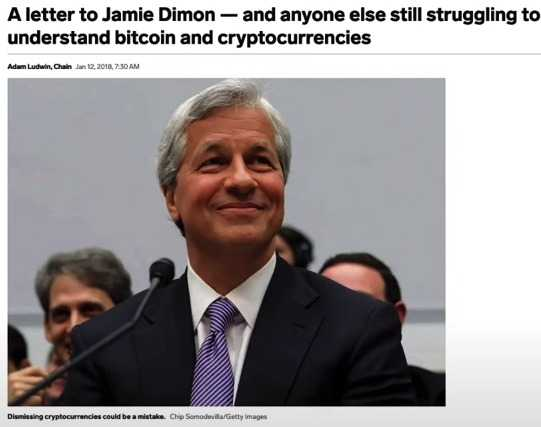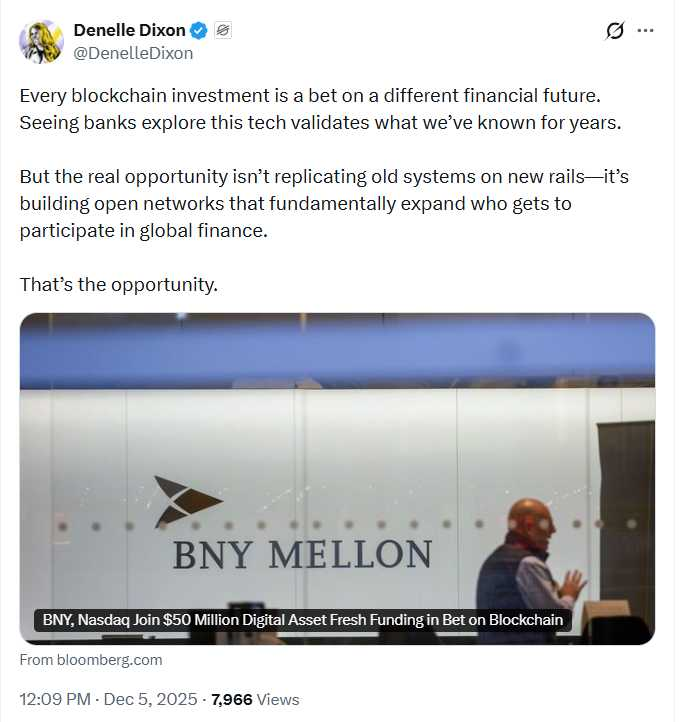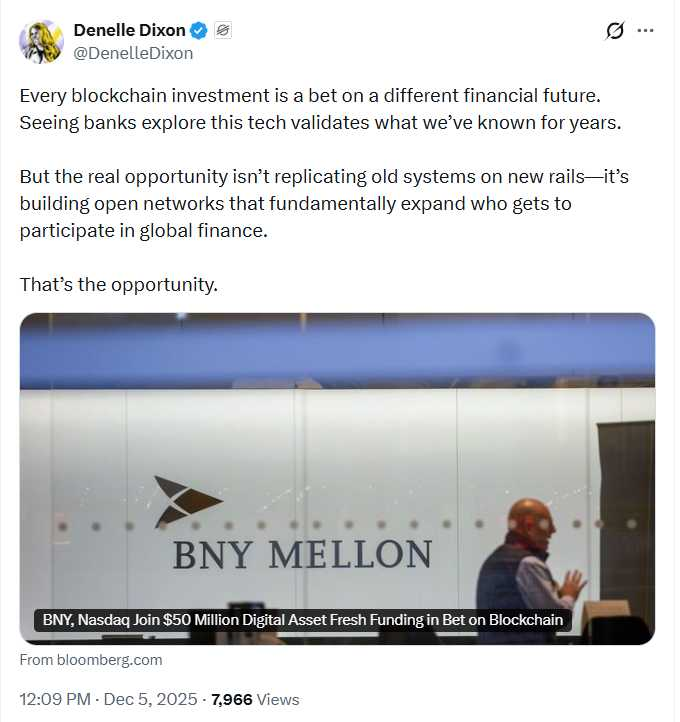(Dinarian Note: This letter has been virtually erased from the internet. It was a letter written by Chain's (Now Being Rebranded as "ONYX") Co-Founder and CEO, to Jaimie Dimon of JP Morgan, who is working on a new financial program called, yep you guessed it, "ONYX". Onyx will be a inter-Intra bank Unified Ledger Platform. Pure coincidence im sure... I advise everyone read this, then watch the video below and it will connect the dots nicely as to why this letter is so darn IMPORTANT...)
To Mr. Dimon, and anyone struggling to understand cryptocurrencies.
Hi Mr Damon, I'm Adam Ludwin and I have a company called "Chain". I have been working in the cryptocurrency field for many years. You spoke publicly about Bitcoin last week:

It is not difficult to convince people that cryptocurrencies have no intrinsic value, or that governments will easily destroy them.
At the same time, another theory is becoming more and more popular: that cryptocurrencies will rewrite the way banks and governments operate, and then Silicon Valley giants will rule the world.
Both extreme statements are not true.
The real facts are carefully understood and are very important.
That's why I decided to write this letter to you, hoping it will help you gain a deeper understanding of what cryptocurrencies really are. Let me start with what I believe: the current cryptocurrency market is overheated and irrationally exuberant. There are a lot of people who pretend to be creating cryptocurrencies and scams are everywhere.
- Few people in the media understand what it's all about
- Few people in finance understand what it's all about
- Few people in technology understand what it's all about
- Few people in academia and politics understand what it's all about
- Few of the people who buy crypto understand how it all works and probably neither do I.
Besides: Banks and governments are not going away, traditional software is not going away either.
To put it simply: there is a lot of noise, but there is also a real message in it. To grasp it, we need to start by defining a cryptocurrency. Without a specific definition in place, when most people argue about cryptocurrencies, they are talking differently. Because they never stopped to ask each other's definition of cryptocurrency.
Here's my definition: "Cryptocurrency is a new asset class characterized by its ability to power decentralized applications".
If I'm right, your view of cryptocurrencies really has to come from your view of decentralized applications and their value compared to current software models, not from your view of traditional currencies or securities Regardless of its evaluation. If you don't have an opinion on decentralized applications, then, sorry, you can't have an opinion on cryptocurrencies yet.
Please read on!
Since this is not a comparison between cryptocurrencies and traditional currencies, let's stop using the word "currency". This is a misnomer, the word has too many connotations. Mr. Dimon, I noticed that when you talk about bitcoin publicly, you often compare it to the dollar, the euro, the yen, etc. Such analogies will not help you understand the truth of the matter. In fact, it can actually get in the way. So, next, I will use "crypto assets" to refer to so-called cryptocurrencies. Let’s review: cryptocurrencies are a new asset class that is uniquely positioned to power decentralized applications.
As with other classes of assets, there must exist a mechanism for allocating resources to a particular form of organization. Although the recent short-sighted focus of all parties has been on the trading of encrypted assets, the purpose of their existence is not just to be traded.
That said, crypto assets are not meant to exist, at least in principle. To help you understand, we can refer to other asset classes and the organization of their corresponding services: Company Shares vs. Corporations Government Bonds v.s. State, Levels of Government Mortgages vs. Asset Owners Then, now we're talking about: Cryptoassets v.s. Decentralized Applications.
Decentralized applications are a new form of organization, and a new form of software: a new model of creating, supporting, and operating software services in a completely decentralized manner. This does not mean that this new model must be better or worse than the existing software operation methods or companies.
We'll discuss the main pros and cons of this in a moment. We can only say that encrypted assets and decentralized applications are fundamentally different from the current software operations and their corresponding organizational forms that we are familiar with.
How different?
Think of this analogy: You grow up in a rainforest, and I give you a cactus and tell you it's a tree. How would you react? You might laugh and say it's not a tree, because a tree doesn't have to store a bunch of water in its body and then protect it with armor. Yes, after all, in the tropical rainforest, water is everywhere! This is pretty much the first reaction of many people working in Silicon Valley to decentralized applications. I digress, I should give you a good explanation:
What are decentralized applications?
Decentralized applications are a way of creating services that don't have a single actor. We'll discuss whether they actually have value in a moment, but for now, you need to understand how they work.
Let's go back to the beginning of this idea.
It was November 2008, and the financial crisis was sweeping the world. An anonymous author published a paper explaining how to build a viable electronic payment system without a trusted third party such as Chase, PayPal, or the Federal Reserve Bank. This is the first time in history that a decentralized application of this type has been proposed. It's about decentralized applications for payments.
The title of the paper is: Bitcoin
How does this work?
How is it possible to send an electronic payment without a pre-designated entity that can track and update everyone's account balance?
Electronic data is not a bearer instrument, and data requires a reliable intermediary and authentication.
This paper proposes a solution: form a peer-to-peer network, open the network, and publish every transaction to everyone on the network.
When you post a transaction, point to the account information on this network involved in the transaction. Use encryption principles to sign your release with the software key of the account so that others can confirm that it is your account.
Nearly working, there is one more requirement: if there are two releases competing with each other (ie, you want to spend the same money twice) only one release will be adopted. Wrong solution: Design a unit that timestamps transactions, and then incorporates the earliest.
But in this way, you have to rely on a third-party unit, which is tantamount to doing nothing. An epoch-making solution: Let all units compete to be "time stamp executors"! We must have a unit to perform the action, but we can avoid appointing a specific person in advance, or using the same person every time, to perform the action.
"Let's compete!" sounds like a market economy. What is missing? Competitive rewards. excitation. Or, assets. Let's call this asset "Bitcoin". Let's call the parties competing to validate the timestamp of the latest batch of transactions "miners". Let's open up the code and the web so anyone can join the race at any time. Now, we need a real competition.
This article shows a way: get ready, start! Find a random number generated by the Internet! This random number is very, very difficult to solve, so difficult that the only way is to use a lot of computing power and consume electricity to find it. Just like in "Charlie and the Chocolate Factory", the spoiled Veruca asked her father and the poor laborers to help her find a lucky golden ticket to visit the chocolate factory, and the miners used calculations to search for their lucky gold "number" ".
Why such deliberate and resource-intensive competition for something as simple as timestamping the network? Because we want to ensure that the competitors will pay the real cost for this, so that if they really win the game of finding random numbers and become the designated time stamp executors, they will not do evil with this power (such as review transactions).
Instead, they diligently scan every pending transaction, weed out any users attempting to double-spend the same funds, ensure all rules are followed, and broadcast authenticated batches to other network participants.
Because if they play by the rules, the network is designed to reward them...in newly minted bitcoins, and transaction fees in bitcoins for those who want to transact. (Can we now know why they are called miners instead of timestamp messengers?)
That is to say, miners follow the rules because of self-interested motives and act beneficial to the entire network. You know, Adam Smith, the father of economics, said:
Our supper is not in the benevolence of the butcher, the vintner, or the baker, but in their regard to their own interests.
Encrypted Assets: The Invisible Hand of the Internet.
Bitcoin is capitalism, pure and simple. You should love it!
So, now that these miners have bills to pay (mainly electricity), they should sell their newly earned bitcoins on the open market for whatever fiat they need to pay for them, and the rest is profit. So bitcoins will go into circulation, bought by those who need them, and even speculators can participate (more on who “needs” it, and who speculates later.)
Got it?
This kills two birds with one stone: a financial asset that replaces our need for a trusted centralized authority with a market of In the payment network, it is used as a digital bearer paper for circulation (yes! This is a circular argument, I know.) Now that you understand Bitcoin, let's further extend this logic to the discussion of decentralized applications as a whole superior.
Generally speaking, decentralized applications allow us to do many things (such as payments) that we can do today without a trusted central authority. Another example: Filecoin, a decentralized application, allows users to store files on computers in a peer-to-peer network without the need for centralized file storage services such as Dropbox or Amazon's S3.
The app's encrypted asset, also called Filecoin, is used to incentivize the public to share excess hard drive space with the network. Digital file storage is not a new concept, nor is electronic payment.
What's new is that these services don't need a company to operate, which is a new form of organization. Let's talk about another example. Be warned, this can be a bit confusing as the application is a much lower level concept.
There is a decentralized application called "Ethereum" (Ethereum), Ethereum is a decentralized application for building decentralized applications.
I believe that most readers have heard the words ICO (Initial Coin Offering) and Token (token), most of which are issued on Ethereum. To build a decentralized application, you don't have to start from scratch like Bitcoin, you can choose to do it on Ethereum because: a) the network is already working, and b) it is specially designed to build various applications. sex platform.
Ethereum's protocol is designed to incentivize parties to contribute computing resources to the network in order to earn Ether (Ether; Ethereum's encrypted asset). This makes Ethereum a new computing platform for decentralized applications of these new types of software.
This is not cloud computing, because Ethereum itself is decentralized (you can look up the meaning of the word ether in the history of physics), which is why its founder, Vitalik Buterin, calls Ethereum the "world computer." To sum it up, in just a few short years, the world has found a way to build software services without a central operator.
These services are called decentralized applications, and the main key is to use encrypted assets to motivate non-specific people on the network to contribute the resources required to provide services, including computing, storage, computing, etc. At this point, you can take a breath and feel that this thing is actually amazing.
All we need is the Internet, a set of open protocols, and a new type of asset, and we can build a network that can organically integrate resources and provide various services. Many people believe that this is the path that all software will eventually take in the future, and that this can fundamentally challenge the four kings of FANG (Annotation: Facebook, Amazon, Netflix, Google) and venture capital.
Except for one feature.
And this is not just a superior property of all decentralized applications, it's the only way we know how to do it.
What am I talking about? That is, censorship resistance.
This is the real message that is not easy to grasp in the interference I mentioned. Free from censorship means: the use of decentralized applications is open and unrestricted, and service transactions cannot be stopped.
More specifically, there is nothing stopping me from sending bitcoins to whoever I want, nothing stopping me from executing code on Ethereum, nothing stopping me from storing files on the Filecoin network... just I can connect to the network and pay network transaction fees with the corresponding encrypted assets, and I am free to do whatever I want. (If Bitcoin is pure capitalism, it's also pure freedom. This is where libertarians might be obsessed.) If you're a cryptocurrency fanatic and don't want to take my word for it, at least you're willing to listen.
What did Adam Back say to Charlie Lee?

So, we certainly cannot say that Bitcoin is better than Visa for everyone, but it is possible that for some users, Bitcoin is the only way they can pay. We can ask the question: "For whom does this trade-off make sense?

Who needs freedom from censorship over the speed, cost, scalability, and user experience of a centralized service?
If decentralized applications are to be valuable to a certain group of people, then they must choose such services out of the consideration of being free from censorship.
Of course, this is not from the point of view of investment speculation, but in essence. Who are these people? Although there is not very complete data to analyze, it seems that users of decentralized applications can be roughly divided into the following two categories:
- People who want to connect to the world: There are many parts of the world where people don't get enough services that operate in traditional ways, but still have ways to get online.
- People who don't want to be connected to the world: Anyone who doesn't want their transactions reviewed or known.
Under this framework, one can further ask:
- For whom is Bitcoin the best or only form of payment?
- For whom is Filecoin the best or only way to store files?
- For whom is Ethereum the best or only way to execute programs?
These questions point directly to the ultimate value behind this technology.
Currently, most decentralized applications are not of much use. In the case of Bitcoin, fewer mainstream U.S. merchants accept it as a payment option than in 2014.
A lot of people talk about the use of Bitcoin as a payment system in developing countries, but in China for example, traditional software applications such as Alipay or WeChat Pay are really the way to drive the big revolution in payments here.
At the same time, the considerations of using bitcoin on the darknet or ransomware are obvious.
But don't people use Bitcoin for "store of value" reasons?
Of course, this is just another claim that people invest in Bitcoin to hold it for the long term. But remember I haven't talked about investing in cryptoassets, I'm talking about whether decentralized payment applications powered by this asset are useful to some people.
Only on the premise that human beings are willing to live and work in buildings in the future can real estate have the function of long-term value preservation. The same goes for decentralized applications.
So how to understand Ethereum in terms of immunity from censorship? After all, it seems like a lot of developers are using it these days.
Since Ethereum is a development platform for decentralized applications, are many developers being censored or restricted? In a way, yes. Developers or new entrepreneurs who want to develop financial products do not have open and unlimited access to the world's financial infrastructure.
Of course, Ethereum has no way to provide such usage rights, but it provides another different infrastructure for all parties to use, such as creating and executing a financial contract.
Because Ethereum is a platform, its ultimate value comes from the sum of the value of the applications built on it. In other words, we can evaluate whether Ethereum is useful by looking at whether things built on Ethereum are useful. For example, do we need a censorship-free prediction market? Censorship-free meme? A censorship-free YouTube or Twitter?
It’s still early days, but if none of the 730+ decentralized applications that have been created on Ethereum so far seem to be useful, then it seems like something is going to mean something. Even in the first year of the internet, there were chat rooms, e-mail, cat photos and sports scores worth talking about. Where is Ethereum's killer app today?
Decentralized applications have characteristics so different from the software applications we know and love, is anyone really going to use them? Do they have the chance to become an integral part of the economic system? It's hard to say, because the answer, although related to the technological evolution of the technology, is more important to society's acceptance of them.
For example, sending encrypted messages is usually only used by hackers, spies and neurotic users, and this phenomenon does not seem to change until recently, after the Snowden and Trump era, almost everyone from Silicon Valley to the Acela corridor started using Signal or It's Telegram, WhatsApp is end-to-end encrypted, and the press uses SecureDrop to pay fees... There have been some improvements in technology in this area, but the most important thing is that social changes are driving popularization.
In other words, we grew up in the rainforest, but sometimes the environment changes, and it would be helpful to know how to adapt to other environments.
This is the basic discourse on investing in encrypted assets and decentralized applications at present: it is still too early to draw conclusions, this change is too big, if one or two decentralized applications really become part of the future world, then the Cryptoassets are going to be extremely valuable, so invest early and see how things play out, don't quit just because you haven't seen a killer app yet.
That's a pretty good statement, and I'm inclined to agree.
Let me summarize: In the long run, the value of cryptoassets is driven by the usage of the decentralized applications they support. Although it is still early, the current high valuation still makes sense, because even if the probability of mass popularization is not high, the potential impact is huge, so it is not bad to get in the car first and follow along to see the future development.
But how to explain the latest madness?
Bitcoin has increased five times within a year, and Ethereum has increased thirty times. The total market capitalization of cryptocurrencies has soared to as high as $175 billion from $12 billion a year ago. Why? (Annotation: This is the statistics of 2017.10.17)
As with all crazy history, irrationality is the most rational option right now.
In order to understand the truth of the matter, let us examine the thinking logic of buyers and sellers. Start with the buyer.
If you started investing in bitcoin or ethereum early on, you made a windfall. In psychology, it is called the "banker effect". You start to disregard this money as your real money. You feel that you are very powerful and more willing to take risks, and you may even spread the risk to one or two other encrypted assets.
If you haven't invested yet, the fear of missing out continues to build up until the moment comes when you go all out and buy. Maybe you just saw the news about Bitcoin and didn't understand it, so you followed Buffett's (good) advice and didn't buy it. Friends around you bought it and made money, but you still ignored them. Then you saw the news about Ethereum, and you didn’t understand it, and you didn’t buy it, and then your friends bought it and started planning for retirement. This lesson seems to be contrary to Buffett's teachings. It seems that you should only invest in things you don't understand? So people started rechecking their investment logic from the ground up, and when Bitcoin hit new highs, they finally got in.
it's not a good thing.
Because, there will always be sellers in the market to fill the demand, especially when the demand comes from a group of people who think they will never understand and decide to bet their money on anything that sounds complicated and can make a big difference.
Check out the seller now. I don't mean the people who buy and sell, but the issuers, the teams that create new cryptoassets.
The basic model is: before the planned decentralized application is launched, a certain proportion of newly created encrypted assets is pre-sold for development funds. This means that the funds so raised are a) non-dilutive, not securities, and b) not debt, and you have no obligation to pay anyone back. Basically free money, even the dot-com bubble of the 90s wasn't such a good thing, it was the golden age of entrepreneurs. Therefore, this lure attracts people from all walks of life to rush into ICOs, not even to develop decentralized applications. After all, an ICO can get you out of the game before it goes live!
There is another effect that catalyzes entrepreneurs to create new encrypted assets: selling encrypted assets early creates a group of "visionary investors" who bought your assets early and actively assist you in promoting them. Impossible to exist.
The problem with this kind of thinking is that it merges the roles of early investors and early adopters. There is very little overlap between people who buy digital assets and people who use services associated with them, especially in the current market situation. This creates an illusion of product versus market. Yes, people are buying your cryptocurrency, but only because they want to get rich, and what you're selling is "the way to get rich".

But "it's okay" because everyone is getting rich right now.
The most rational choice right now is to be irrational.
As long as that line graph is always going up.
Only when the tide goes out do you know who's without pants.
At the same time, I would not be bearish on crypto assets.
Those who live off crystal balls end up swallowing broken glass.
Consider the following scenario: the total market value of encrypted assets increases by an order of magnitude every few years, so how much will it reach in 2022? It is certain that many (or most?) cryptoassets created today will not exist then, but many cryptoassets (known as altcoins) started in 2013/2014 are also long gone now. The only exception is Ethereum, which has driven this wave of enthusiasm by relying on platform functions to support other encrypted assets.

Mr. Dimon, what is the conclusion?
Let me conclude by summarizing.
- Cryptocurrencies (what I prefer to call cryptoassets) are a new asset class for the development of decentralized applications.
- Decentralized applications provide services that we already enjoy today, such as payment, storage or computing, but the difference is that the services here do not need a centralized institution.
- This new way of operating software is useful for people who need protection from censorship, often because they either can't use normal services or don't want to be identified.
- It is better for most people to use the current normal application services, because they are 10 times better than decentralized applications in all aspects, at least for now.
- Society's embrace or rejection of new technologies is hard to predict (think of the example of encrypted communications).
- In the long run, the value of encrypted assets depends on whether the decentralized applications they provide are useful. In the short term, the volatility will be intense, with FOMO competing with FUD, doubt competing with understanding, greed competing with fear (both buyers and sellers).
- Most people who buy crypto assets have re-examined their investment logic.
- Most of the sellers who create new crypto assets are not actually building dapps, they are just selling their new tokens along the mad bull market; this does not mean that dapps are bad, it just means that someone is taking advantage of ignorance , and even they themselves know little about it.
- Don’t take the long-term view of cryptoassets in a bad light: we’re approaching the 10th anniversary of the Bitcoin thesis, cryptoassets are still showing no signs of fading, and decentralized applications are likely to have a place in the world like the ones we’ve long taken for granted same organization.
I wish you well,
Adam
p.s. — You may have noticed that I didn't use the word "blockchain", which I think probably created more confusion than knowledge.
p.p.s.—There is a related topic that I did not mention here: encrypted ledgers used by enterprises. My views on this can be found here.
(Annotation: All pictures come from the original content)




























